Exposure of Carboniferous Granitoids on Triassic–Jurassic Seashores in the Western Caucasus: A Stratigraphical Review
Abstract
:1. Introduction
2. Geological Setting
3. Material and Methods
4. Results
4.1. Key Localities of Coarse Siliciclastic Beds Associated with Three Crystalline Massifs
4.2. Ages of Coarse Siliciclastic Beds Associated with Crystalline Massifs
4.3. Stratigraphical Correlation of Coarse Siliciclastic Beds Associated with Crystalline Massifs
5. Discussion and Conclusions
5.1. Modelling Exposure of Crystalline Massifs on Ancient Seashores
5.2. Additional Inferences
5.3. Conclusive Remarks
Funding
Data Availability Statement
Acknowledgments
Conflicts of Interest
References
- Erdmann, W.; Scheffers, A.M.; Kelletat, D.H. Holocene Coastal Sedimentation in a Rocky Environment: Geomorphological Evidence from the Aran Islands and Galway Bay (Western Ireland). J. Coast. Res. 2018, 34, 772–792. [Google Scholar] [CrossRef]
- Felton, E.A. Sedimentology of rocky shorelines: 1. A review of the problem, with analytical methods, and insights gained from the Hulopoe Gravel and the modern rocky shoreline of Lanai, Hawaii. Sediment. Geol. 2002, 152, 221–245. [Google Scholar] [CrossRef]
- Manikam, S.L.; Green, A.N.; Cooper, A.; Deacon, G.; Flemming, B. Development and preservation of transgressive sandy versus rocky shorelines: Observations from the SE African shelf. Geomorphology 2022, 419, 108485. [Google Scholar] [CrossRef]
- Trenhaile, A.S. Climate change and its impact on rock coasts. Geol. Soc. Mem. 2014, 40, 7–17. [Google Scholar] [CrossRef]
- Violante, C. Rocky coast: Geological constraints for hazard assessment. Geol. Soc. Spec. Publ. 2009, 322, 1–31. [Google Scholar] [CrossRef]
- Johnson, M.E. Why are ancient rocky shores so uncommon? J. Geol. 1988, 96, 469–480. [Google Scholar] [CrossRef]
- Johnson, M.E. Uniformitarianism as a guide to rocky-shore ecosystems in the geological record. Can. J. Earth Sci. 2006, 43, 1119–1147. [Google Scholar] [CrossRef]
- Johnson, M.E. Ecology of Intertidal Rocky Shores Related to Examples of Coastal Geology across Phanerozoic Time. J. Mar. Sci. Eng. 2024, 12, 1399. [Google Scholar] [CrossRef]
- Bizzarri, R. Early Pleistocene rocky coasts (Orvieto area, Western Umbria, Central Italy): Facies analysis and sedimentation models. Ital. J. Geosci. 2010, 129, 251–268. [Google Scholar]
- Chatalov, A.; Ivanova, D.; Bonev, N. Transgressive Eocene clastic-carbonate sediments from the Circum-Rhodope belt, northeastern Greece: Implications for a rocky shore palaeoenvironment. Geol. J. 2015, 50, 799–810. [Google Scholar] [CrossRef]
- Desrochers, A. Rocky shoreline deposits in the Lower Silurian (upper Llandovery, Telychian) Chicotte Formation, Anticosti Island, Quebec. Can. J. Earth Sci. 2006, 43, 1205–1214. [Google Scholar] [CrossRef]
- Foix, N.; Ocampo, S.M.; Paredes, J.M.; Allard, J.O.; Giacosa, R.E.; González, P.D.; Olazábal, S.X. Maastrichtian-Danian Northpatagonian rocky shore, Argentina. Sediment. Geol. 2023, 454, 106463. [Google Scholar] [CrossRef]
- Harland, T.L.; Pickerill, R.K. Ordovician rocky shoreline deposits–the basal Trenton Group around Quebec City, Canada. Geol. J. 1984, 19, 271–298. [Google Scholar] [CrossRef]
- Rousse, S.; Duringer, P.; Stapf, K.R.G. An exceptional rocky shore preserved during Oligocene (Late Rupelian) transgression in the Upper Rhine Graben (Mainz Basin, Germany). Geol. J. 2012, 47, 388–408. [Google Scholar] [CrossRef]
- Surlyk, F.; Sørensen, A.M. An early Campanian rocky shore at Ivö Klack, southern Sweden. Cretac. Res. 2010, 31, 567–576. [Google Scholar] [CrossRef]
- Kennedy, D.M.; Ierodiaconou, D.; Schimel, A. Granitic coastal geomorphology: Applying integrated terrestrial and bathymetric LiDAR with multibeam sonar to examine coastal landscape evolution. Earth Surf. Process. Landf. 2014, 39, 1663–1674. [Google Scholar] [CrossRef]
- Nehyba, S.; Roetzel, R. High-energy, microtidal nearshore deposits and their provenance (Lower Miocene, Burdigalian/Eggenburgian, Alpine-Carpathian Foredeep, Lower Austria). Geol. Q. 2022, 66, 33. [Google Scholar] [CrossRef]
- Puig López, J.M.; Howell, J.; Roetzel, R.; Poyatos-Moré, M. Transgressive rocky coasts in the geological record: Insights from Miocene granitic rocky shorelines and modern examples. Sediment. Geol. 2023, 446, 106344. [Google Scholar] [CrossRef]
- Brocx, M.; Semeniuk, V. The ‘8Gs’—A blueprint for Geoheritage, Geoconservation, Geo-education and Geotourism. Aust. J. Earth Sci. 2019, 66, 803–821. [Google Scholar] [CrossRef]
- Mazzucato, E.; de La Corte Bacci, D.; de Gouveia Souza, C.R. Geomorphological Heritage on the North Coast of the State of São Paulo: A Perspective About Current and Past Climate Changes. Geoheritage 2022, 14, 121. [Google Scholar] [CrossRef]
- Nazaruddin, D.A. Granite landforms of Samui Island (southern Thailand) from geoheritage, geoconservation and geotourism perspectives. Int. J. Geoheritage Parks 2020, 8, 75–86. [Google Scholar] [CrossRef]
- Roig-Munar, F.X.; Martín-Prieto, J.Á.; Rodríguez-Perea, A.; Gelabert, B.; Vilaplana, J.M. Proposed geosites for tsunamitic blocks in the rocky coasts of Formentera (Balearic Islands). Rev. Soc. Geol. Esp. 2018, 31, 35–48. [Google Scholar]
- Ruban, D.A. Islands in the Caucasian Sea in Three Mesozoic Time Slices: Novel Dimension of Geoheritage and Geotourism. J. Mar. Sci. Eng. 2022, 10, 1300. [Google Scholar] [CrossRef]
- Ruban, D.A.; Mikhailenko, A.V.; Ermolaev, V.A. Temporal outline of geological heritage sites in the Western Caucasus. Int. J. Geoheritage Parks 2024, 12, 295–310. [Google Scholar] [CrossRef]
- Chaitsky, V.P.; Popkov, V.I.; Popkov, I.V.; Pinchuk, T.N. Triassic of the Northern Caucasus. Geol. Geogr. Glob. Energiya 2020, 77, 11–21. (In Russian) [Google Scholar]
- Chepurnoy, E.A. Sedimentary rocks of the northern contact of the Dakh Crystalline Uplift (Adygeya). In Praktika Geologov na Proizvodstve; Granovskaya, N.V., Ed.; SFU: Rostov-on-Don, Russia, 2021; pp. 132–134. (In Russian) [Google Scholar]
- Diakonova-Savalieva, E.S. Granitoids of the Dakh and Sakhray intrusions. Uchyonye Zap. Leningr. Gos. Univ. Seriya Geol. Pochvennykh Nauk. 1940, 45, 190–223. (In Russian) [Google Scholar]
- Vyalov, O.S.; Nikshich, I.I. Age of Dakh and Shibaba granite intrusion in the Northern Caucasus. Vestn. Geol. Kom. 1928, 9–10, 13–15. (In Russian) [Google Scholar]
- Ismail-Zadeh, A.; Adamia, S.; Chabukiani, A.; Chelidze, T.; Cloetingh, S.; Floyd, M.; Gorshkov, A.; Gvishiani, A.; Ismail-Zadeh, T.; Kaban, M.A.; et al. Geodynamics, seismicity, and seismic hazards of the Caucasus. Earth-Sci. Rev. 2020, 207, 103222. [Google Scholar] [CrossRef]
- Pierce, I.; Guliyev, I.; Yetirmishli, G.; Muradov, R.; Kazimova, S.; Javanshir, R.; De Pascale, G.P.; Johsnon, B.; Marshall, N.; Walker, R.; et al. Surface Rupturing Earthquakes of the Greater Caucasus Frontal Thrusts, Azerbaijan. Tectonics 2024, 43, e2023TC007758. [Google Scholar] [CrossRef]
- Van Hinsbergen, D.J.J.; Torsvik, T.H.; Schmid, S.M.; Matenco, L.C.; Maffione, M.; Vissers, R.L.M.; Gürer, D.; Spakman, W. Orogenic architecture of the Mediterranean region and kinematic reconstruction of its tectonic evolution since the Triassic. Gondwana Res. 2020, 81, 79–229. [Google Scholar]
- Adamia, S.; Alania, V.; Chabukiani, A.; Kutelia, Z.; Sadradze, N. Great Caucasus (Cavcasioni): A long-lived North-Tethyan back-arc basin. Turk. J. Earth Sci. 2011, 20, 611–628. [Google Scholar] [CrossRef]
- Saintot, A.; Brunet, M.-F.; Yakovlev, F.; Sebrier, M.; Stephenson, R.; Ershov, A.; Chalot-Prat, F.; McCann, T. The Mesozoic-Cenozoic tectonic evolution of the Greater Caucasus. Geol. Soc. Mem. 2006, 32, 277–289. [Google Scholar] [CrossRef]
- Scotese, C.R. An Atlas of Phanerozoic Paleogeographic Maps: The Seas Come in and the Seas Go out. Annu. Rev. Earth Planet. Sci. 2021, 49, 679–728. [Google Scholar] [CrossRef]
- Vasey, D.A.; Garcia, L.; Cowgill, E.; Trexler, C.C.; Godoladze, T. Episodic evolution of a protracted convergent margin revealed by detrital zircon geochronology in the Greater Caucasus. Basin Res. 2024, 36, e12825. [Google Scholar] [CrossRef]
- Popov, Y.V.; Sharova, T.V. Formations and Structure-Formation Zoning of Geological Complexes in the Territory of the Mountainous Part of Adygeya (Greater Caucasus); Southern Federal University: Rostov-on-Don, Russia, 2022. (In Russian) [Google Scholar]
- Somin, M.L.; Levchenkov, O.A.; Kotov, A.B.; Makeev, A.F.; Komarov, A.N.; Ro, N.I.; Lavrishchev, V.A.; Lebedev, V.A. The Paleozoic age of high-pressure metamorphic rocks in the Dakhov Salient, Northwestern Caucasus: Results of U-Pb geochronological investigations. Dokl. Earth Sci. 2007, 416, 1018–1021. [Google Scholar] [CrossRef]
- Gaetani, M.; Garzanti, E.; Poline, R.; Kiricko, Y.; Korsakhov, S.; Cirilli, S.; Nicora, A.; Rettori, R.; Larghi, C.; Bucefalo Palliani, R. Stratigraphic evidence for Cimmerian events in NW Caucasus (Russia). Bull. Société Géologique Fr. 2005, 176, 283–299. [Google Scholar] [CrossRef]
- Rostovtsev, K.O.; Savel’eva, L.M.; Efimova, N.A.; Shvemberger, Y.N. Decision of the 2nd Interdepartmental Regional Stratigraphical Maeeting on the Mesozoic of the Caucasus (Triassic); VSEGEI: Leningrad, Russia, 1979. (In Russian) [Google Scholar]
- Rostovtsev, K.O.; Agaev, V.B.; Azarian, N.R.; Babaev, R.G.; Besnosov, N.V.; Hassanov, N.A.; Zesashvili, V.I.; Lomize, M.G.; Paitschadze, T.A.; Panov, D.I.; et al. Jurassic of the Caucasus; Nauka: St. Petersburg, Russia, 1992. (In Russian) [Google Scholar]
- Ruban, D.A.; Zerfass, H.; Pugatchev, V.I. Triassic synthems of southern South America (southwestern Gondwana) and the Western Caucasus (the northern Neotethys), and global tracing of their boundaries. J. S. Am. Earth Sci. 2009, 28, 155–167. [Google Scholar] [CrossRef]
- Vuks, V.J. Lower and Middle Jurassic Stratigraphic Scheme of the Western Caucasus: Problems of Correlation and Division. In STRATI 2013; Rocha, R., Pais, J., Kullberg, J.C., Finney, S., Eds.; Springer: Cham, Switzerland, 2013; pp. 609–618. (In Russian) [Google Scholar]
- Yasamanov, N.A. Landscape-Climatic Conditions of the Jurassic, the Cretaceous and the Paleogene of the South of the USSR.; Nedra: Moscow, Russia, 1978. (In Russian) [Google Scholar]
- Gale, L.; Rigaud, S.; Gennari, V.; Rettori, R.; Martini, R.; Gaetani, M. Recognition of upper Triassic temperate foraminiferal assemblages: Insights from the Khodz Group (NW Caucasus, Russia). Glob. Planet. Change 2020, 188, 103152. [Google Scholar] [CrossRef]
- Akulov, N.I.; Melnikov, A.I.; Shtelmakh, S.I.; Akulova, V.V.; Hearn, P.P. A geochemical and lithological correlation of lower Jurassic conglomerates in the area surrounding the Lake Baikal rift zone: An improved reconstruction of the region’s palaeogeographic and tectonic evolution. Int. Geol. Rev. 2022, 64, 1–16. [Google Scholar] [CrossRef]
- Alçiçek, H. Stratigraphic correlation of the Neogene basins in southwestern Anatolia: Regional palaeogeographical, palaeoclimatic and tectonic implications. Palaeogeogr. Palaeoclimatol. Palaeoecol. 2010, 291, 297–318. [Google Scholar] [CrossRef]
- Michelsen, O.; Clausen, O.R. Detailed stratigraphic subdivision and regional correlation of the southern Danish Triassic succession. Mar. Pet. Geol. 2002, 19, 563–587. [Google Scholar] [CrossRef]
- Sartori, M.; Gouffon, Y.; Marthaler, M. Harmonization and definition of the Briançonnais lithostratigraphic units in the Penninic nappes of the Valais region. Eclogae Geol. Helv. 2006, 99, 363–407. [Google Scholar] [CrossRef]
- Smith, T.F.; Waterman, M.S. New stratigraphic correlation techniques. J. Geol. 1980, 88, 451–457. [Google Scholar] [CrossRef]
- Haq, B.U. Triassic Eustatic Variations Reexamined. GSA Today 2018, 28, 4–9. [Google Scholar] [CrossRef]
- Haq, B.U. Jurassic sea-level variations: A reappraisal. GSA Today 2018, 28, 4–10. [Google Scholar] [CrossRef]
- Armitage, I.A.; Pemberton, S.G.; Moslow, T.F. Facies succession, stratigraphic occurrence, and paleogeographic context of conglomeratic shorelines within the Father “C”, Spirit River Formation, Deep Basin, west-central Alberta. Bull. Can. Pet. Geol. 2004, 52, 39–56. [Google Scholar] [CrossRef]
- Massari, F. High-frequency cycles within Pleistocene forced-regressive conglomerate wedges (Bradanic area, southern Italy) filling collapse scars. Sedimentology 1997, 44, 939–958. [Google Scholar] [CrossRef]
- Üner, S.; Dirik, K.; Çiner, A. Late Miocene evolution of Kargı fan delta (Aksu basin, Antalya). Earth Sci. 2011, 32, 121–138. [Google Scholar]
- Giorgobiani, T.V. Conditions of formation of the Alpine folded system of the Greater Caucasus and unique features of its structure. Geol. Geofiz. Yuga Ross. 2019, 9, 43–57. [Google Scholar]
- International Commission on Stratigraphy (ICS). International Chronostratigraphic Chart, v2023/09. Available online: https://stratigraphy.org (accessed on 16 May 2024).
- Kushcheva, Y.V.; Latysheva, I.V.; Golovin, D.I.; Gavrilov, Y.O. Textural-structural, mineralogical, isotopic, and age characteristics of Jurassic terrigenous rocks of the northwestern Caucasus (the Belaya River section). Lithol. Miner. Resour. 2007, 42, 257–267. [Google Scholar] [CrossRef]

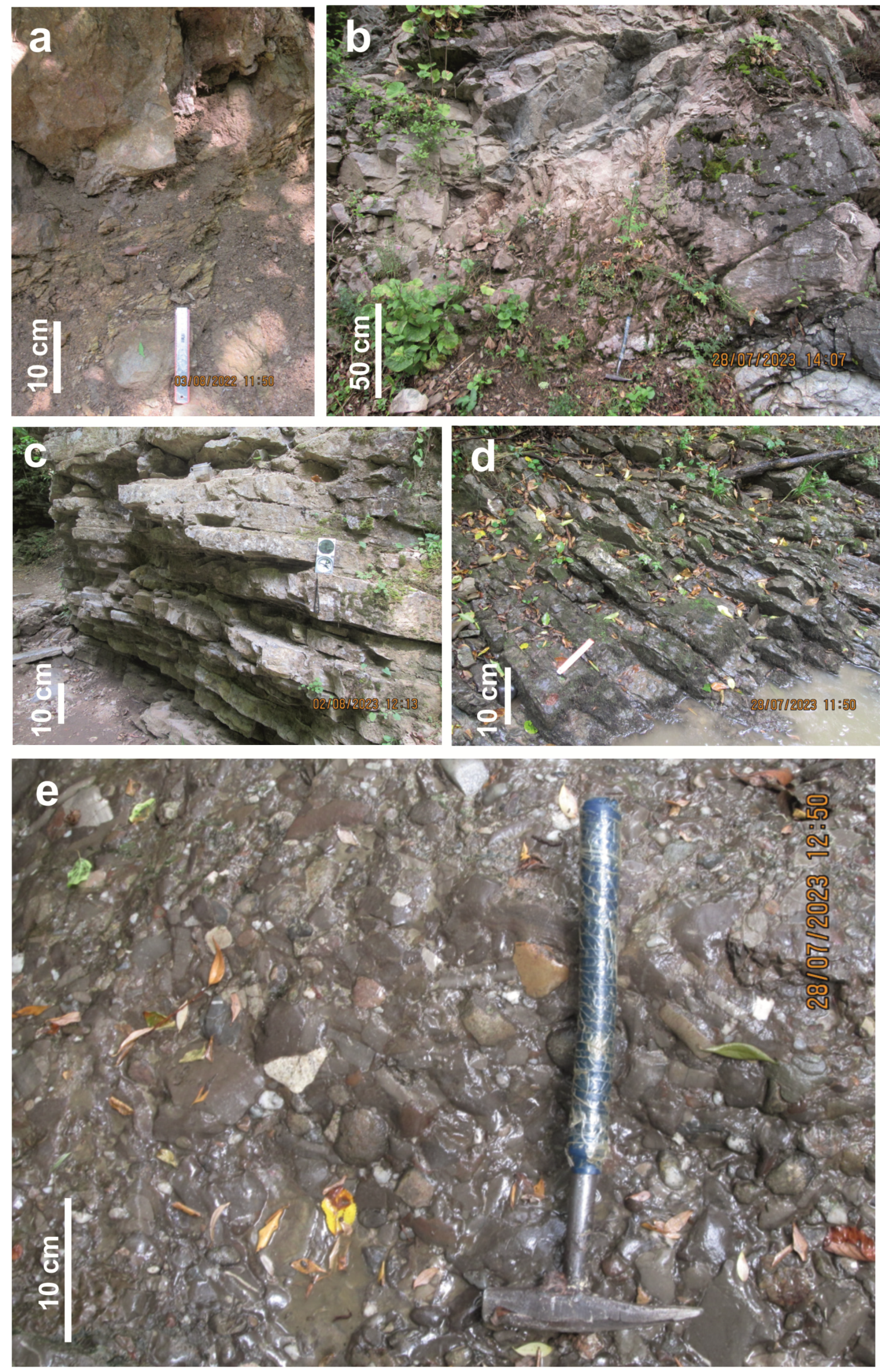
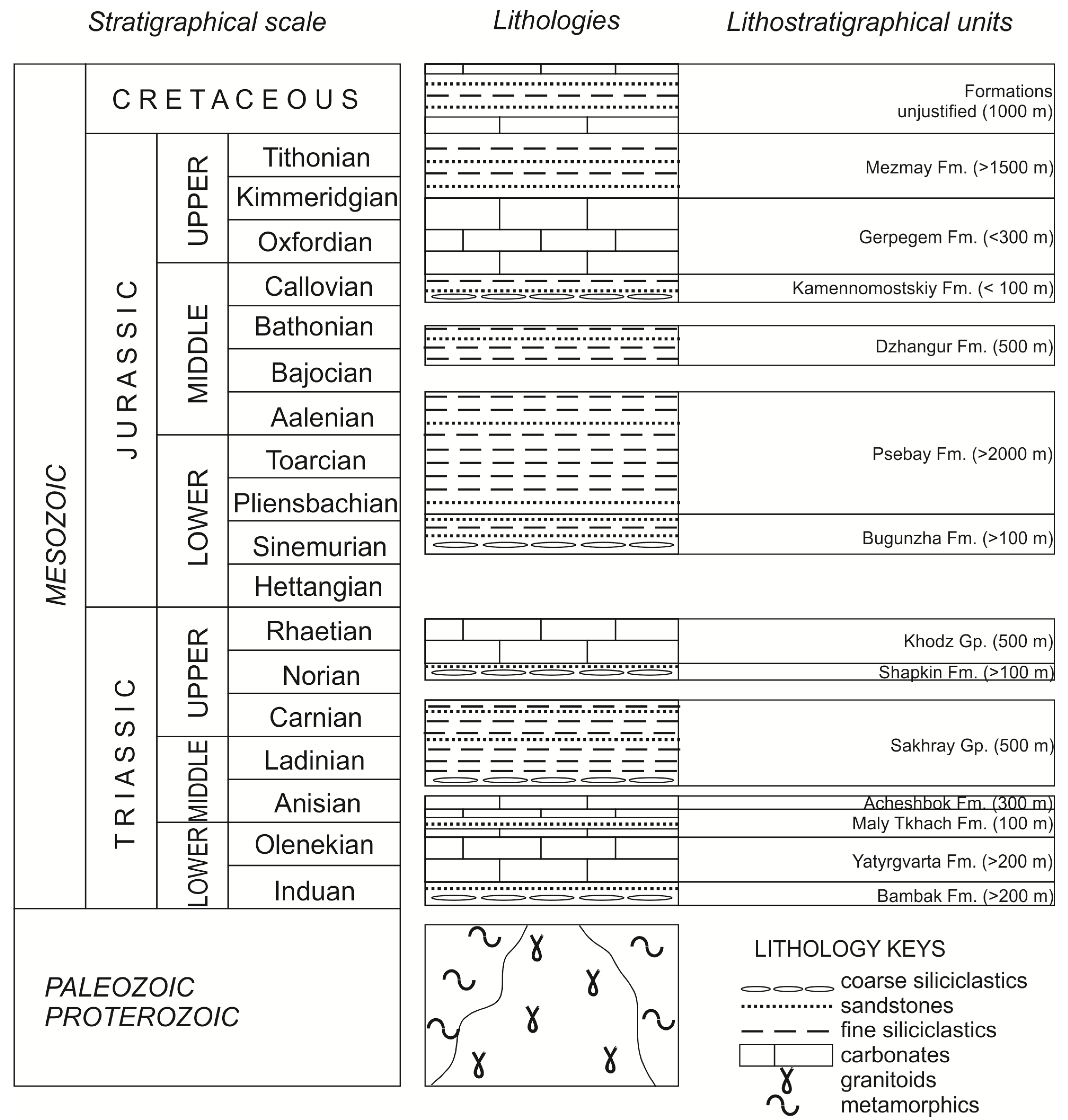
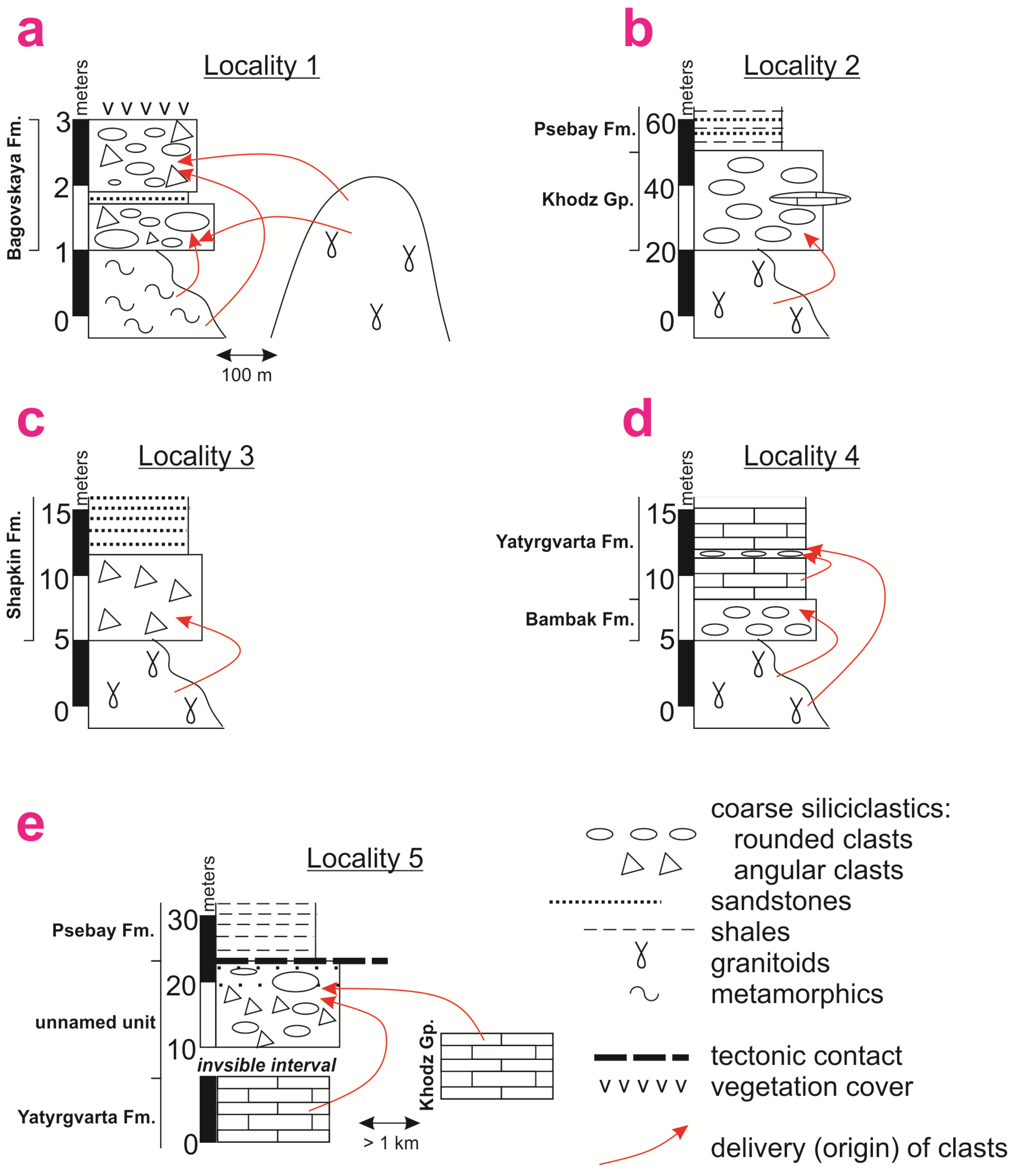
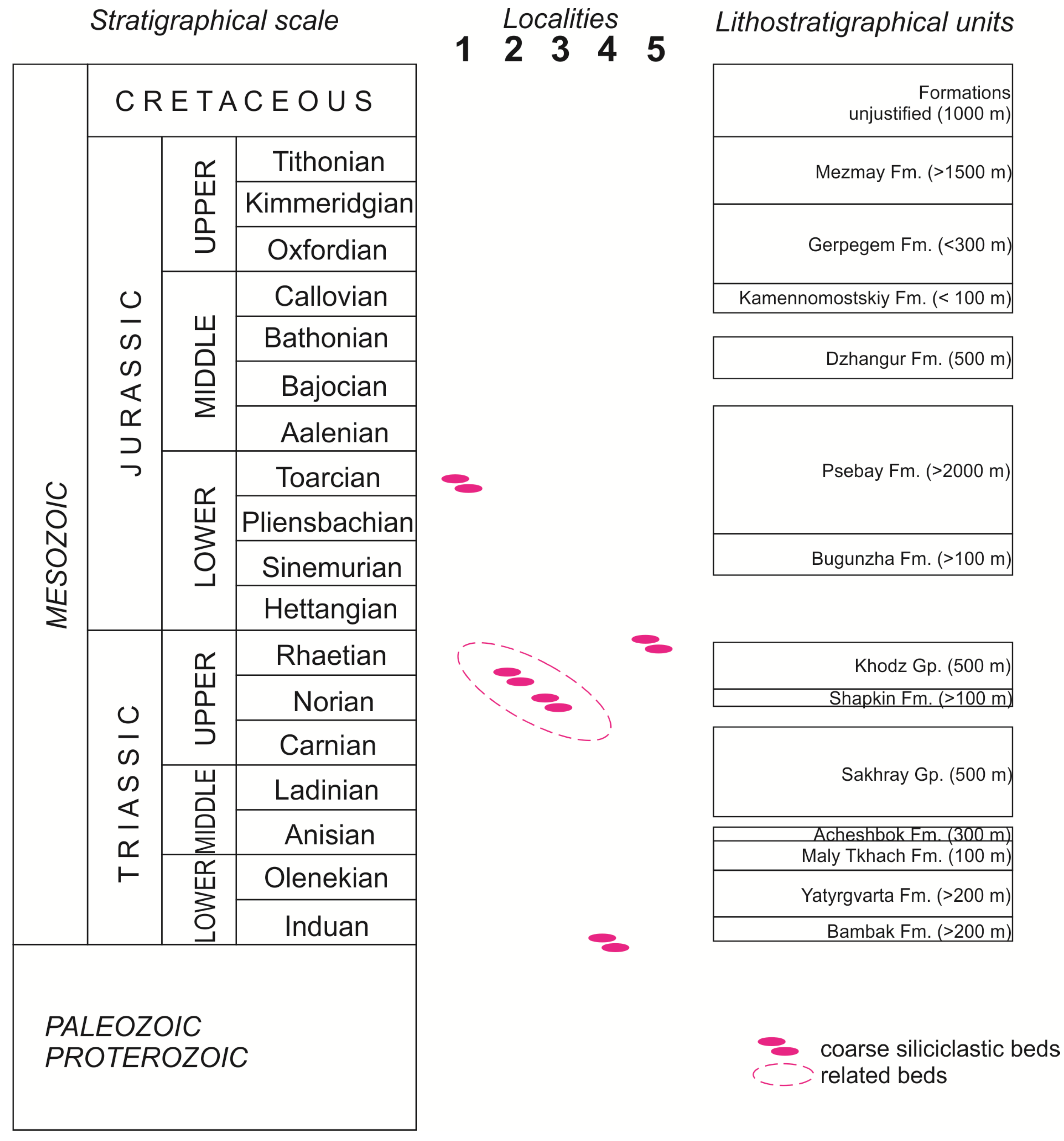
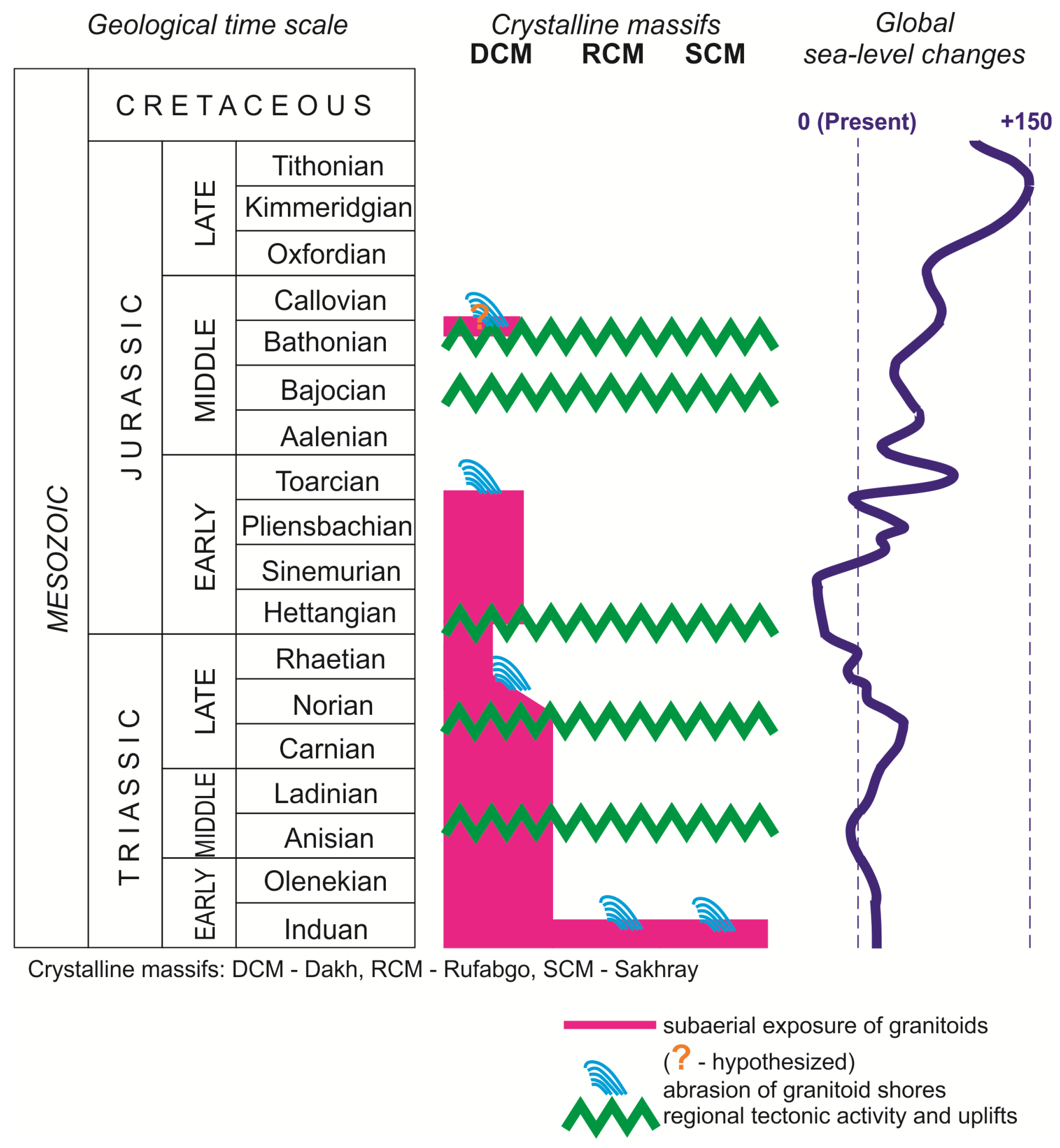

Disclaimer/Publisher’s Note: The statements, opinions and data contained in all publications are solely those of the individual author(s) and contributor(s) and not of MDPI and/or the editor(s). MDPI and/or the editor(s) disclaim responsibility for any injury to people or property resulting from any ideas, methods, instructions or products referred to in the content. |
© 2024 by the author. Licensee MDPI, Basel, Switzerland. This article is an open access article distributed under the terms and conditions of the Creative Commons Attribution (CC BY) license (https://creativecommons.org/licenses/by/4.0/).
Share and Cite
Ruban, D.A. Exposure of Carboniferous Granitoids on Triassic–Jurassic Seashores in the Western Caucasus: A Stratigraphical Review. J. Mar. Sci. Eng. 2024, 12, 1623. https://doi.org/10.3390/jmse12091623
Ruban DA. Exposure of Carboniferous Granitoids on Triassic–Jurassic Seashores in the Western Caucasus: A Stratigraphical Review. Journal of Marine Science and Engineering. 2024; 12(9):1623. https://doi.org/10.3390/jmse12091623
Chicago/Turabian StyleRuban, Dmitry A. 2024. "Exposure of Carboniferous Granitoids on Triassic–Jurassic Seashores in the Western Caucasus: A Stratigraphical Review" Journal of Marine Science and Engineering 12, no. 9: 1623. https://doi.org/10.3390/jmse12091623





